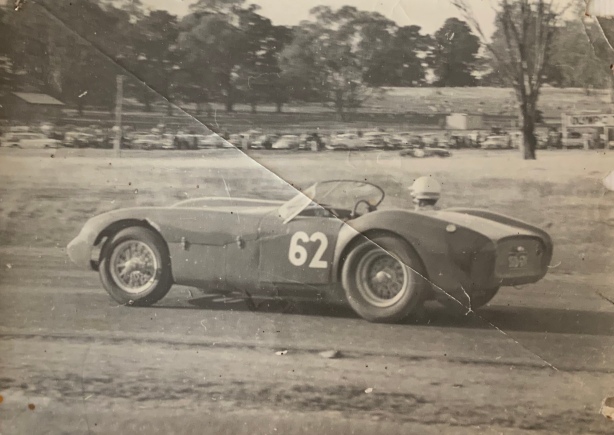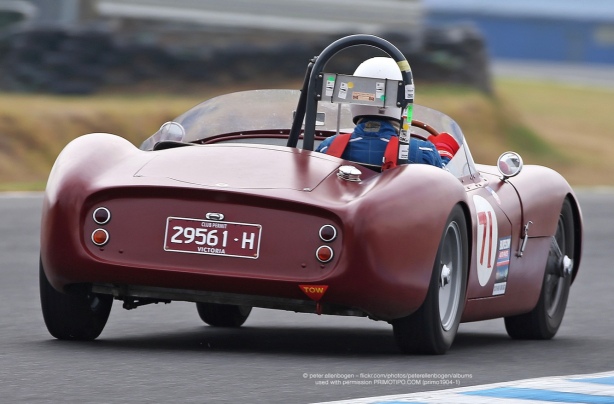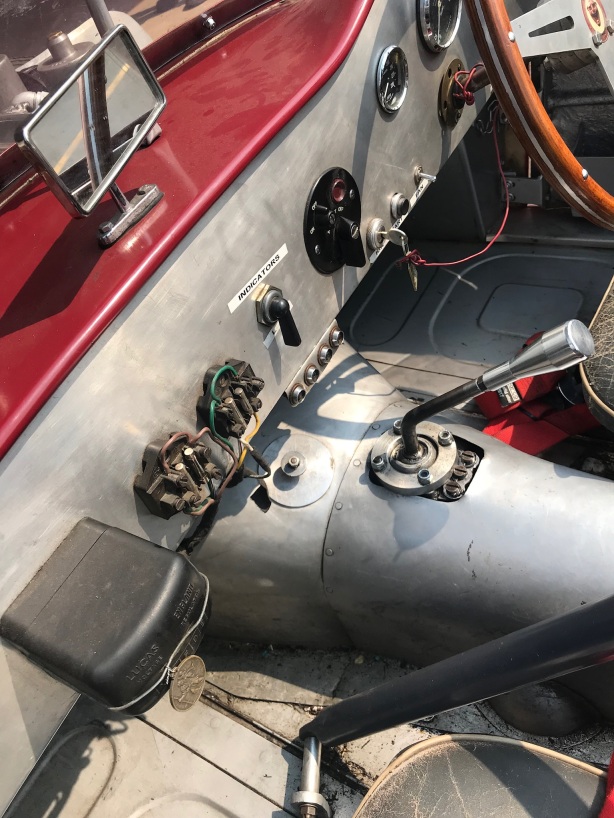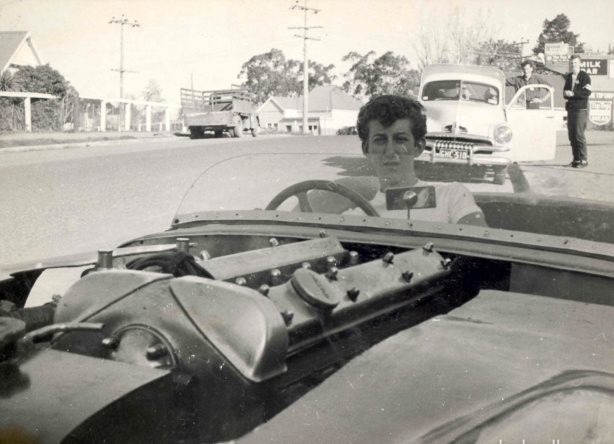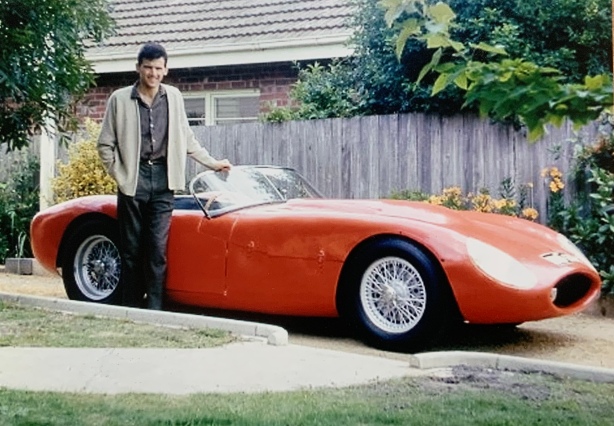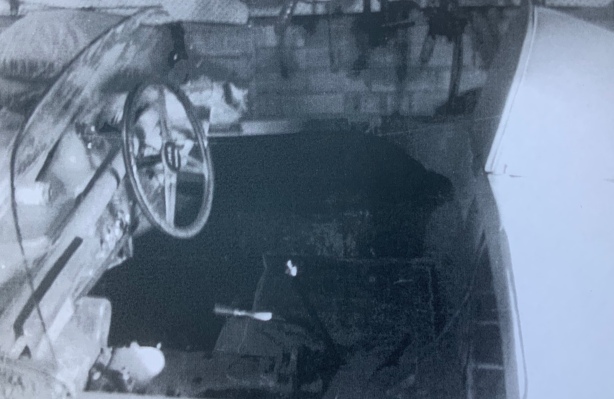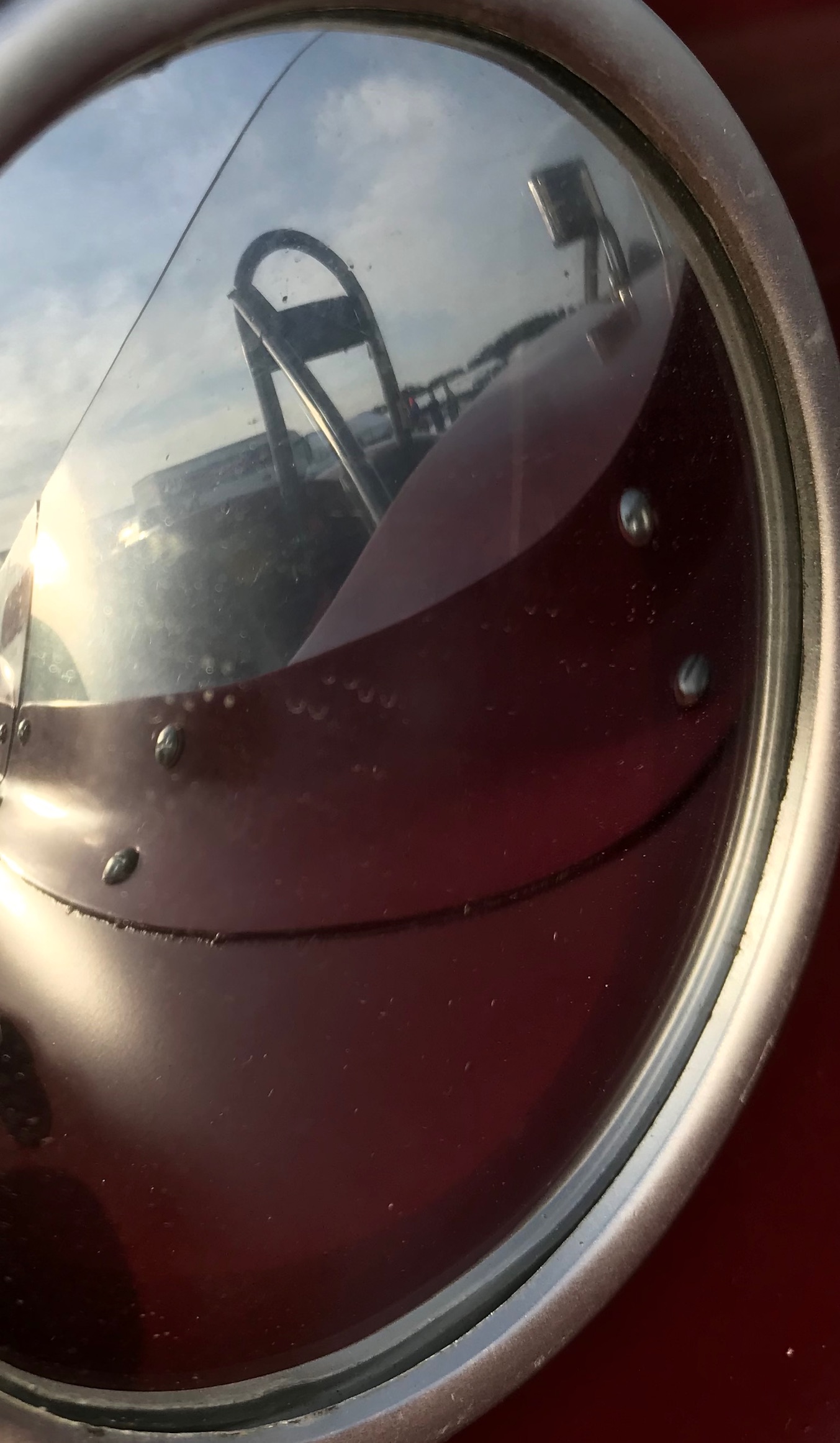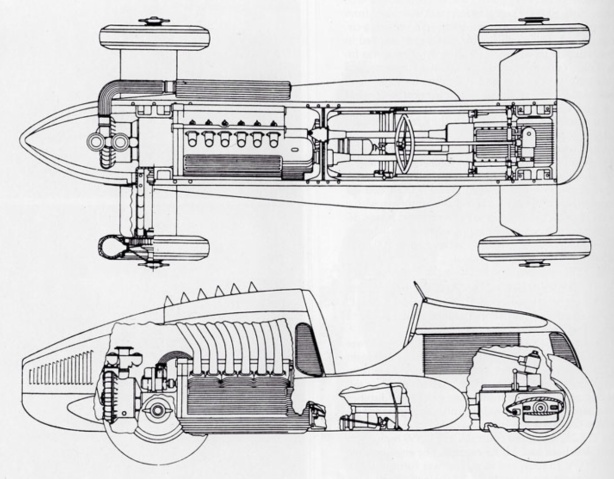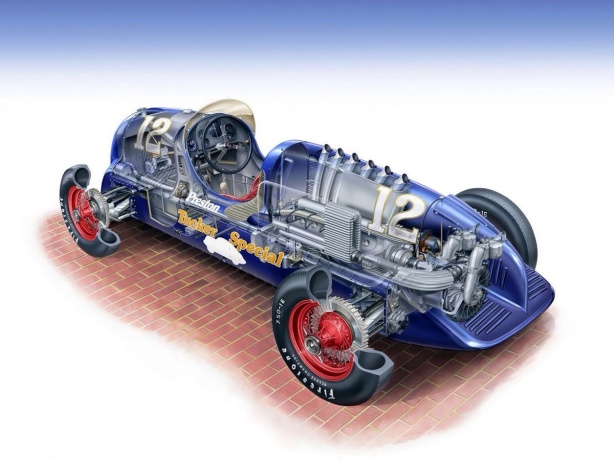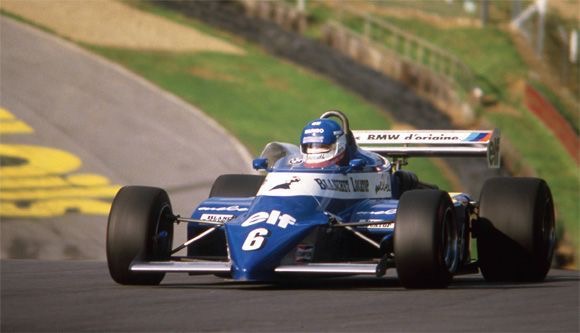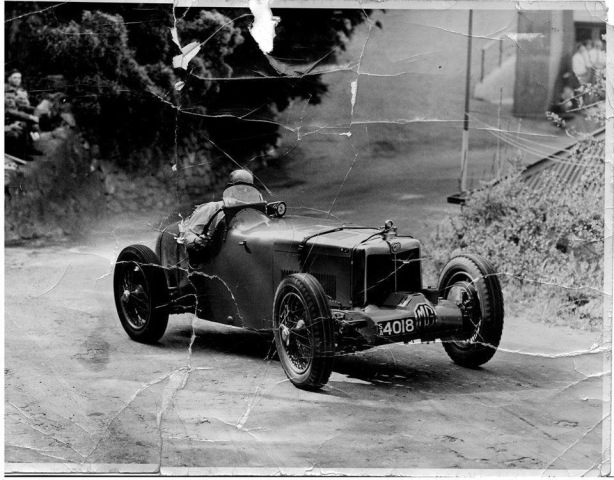Allan McNish in the wonderfully distinctive ‘Crocodile’ livery Audi R8 ahead of David Brabham’s Panoz LMP-1, about to hook into the Adelaide GP circuit’s Chicane early in The Race of 1000 Years on 31 December 2000…
For one wonderful year the sports prototypes raced again in Australia- the race was the final round of the American Le Mans Series.
Allan McNish and Rinaldo Capello won the event- shortened to 850 km from its scheduled 1000 km, from the Franz Konrad/Charles Slater/Alan Heath Lola B2K/10 Ford and the Dodge Viper GTS-R raced by Olivier Beretta/Karl Wendlinger/Dominique Dupuy.
The V8 Supercars have used the shortened Adelaide layout (the Hutt St, Rundle Rd section bypassed in favour of a new straight along Bartels Road) from 1999 but this endurance race used the full GP circuit.
McNish’s quickest lap was a 1:25.2189 seconds, which, while the circuit’s fastest non-F1 race lap is still well shy of Damon Hill’s Williams FW15C Renault 3.5 V10 time of 1:15.381 seconds set during the 1993 AGP.
The history of endurance racing at the time is interesting and somewhat of a ‘might have been’.
The 1999 Le Mans Fuji, and Adelaide Race of a Thousand Years were intended as precursors to a planned Asia Pacific Le Mans Series run by Don Panoz, just as the Silverstone and Nürburgring events run earlier in 2000 were for the European Le Mans Series. The subsequent small number of entries for the European Series in 2001, plus a lack of competitors for a third Asia-Pacific exhibition event to be held at Sepang in Malaysia caused the cancellation of the Asia-Pacific Le Mans Series.
Despite 135,000 fans rocking up in Adelaide, 70,000 on raceday, only the first year of a nine year contract with the South Australian Government was performed.

Stefan Bellof blowing off a Kombi In Dandenong Road in his 956 in December 1984. Porsche Cars Oz workshops were in Noble Park, an adjoining suburb to Sandown Park so why not drive the 3 team cars there, the beasts were tractable enough! The #2 956, crewed by Bellof and Derek Bell won the race from the Mass/Ickx and Palmer/Lammers 956’s (unattributed)
A shame, but the Board of Directors of Melbourne’s Light Car Club of Australia, the promoters of Sandown Park, could have shared a story or two with Adelaide Premier John Olsen about how easy it is to ‘do your balls’ and lose the (club)house if endurance racing was poorly promoted to punters who have always enjoyed a diet of meat ‘n spuds touring cars mixed with meat ‘n spuds touring cars.
The LCCA Board drove the club to oblivion with a shitfully promoted and commercially structured endurance championship event in 1984- loss estimates start at $A300k and stretch to $A500K, a lot in 1984.
Of course, randomly coming across some Adelaide photos got me thinking about these very successful Audis.

McNish in profile 31 December 2000 Audi Sport North America R8 Race of a Thousand Years, Asia-Pacific Le Mans Series (M Turner)

OZ magnesium alloy wheels. Throughout this article there are ‘snippets’ of an R8 which won at Jarama in 2001 and was raced by Katoh/Dalmas/Ara at Le Mans in 2002- I am uncertain as to chassis number- these shots were taken by Darin Schnabel and were sourced from a Sotheby’s ad for the car (D Schnabel)
In their seven year competition history from 1999–2006, the R8 achieved a formidable record of both reliability and success, albeit sometimes not necessarily against the strongest of opposition, losing only 16 races in that period.
The R8 won Le Mans five times- 2000, 2001, 2002, 2004 and 2005, and in addition took the American Le Mans Series seven times, the European Le Mans Series in 2001 and was the Le Mans Series champion in 2004.
The ‘miss’ at Le Mans was in 2003, Audi did not enter ‘factory’ cars that year to allow the R8’s technical and corporate sibling, the Bentley EXP Speed 8 to finish first and second. Click here for a feature on the Speed 8;
The R8 had a late Autumn in its career- the turbocharged diesel V12 engined R10 replaced it in 2006 but it took a while to get it right with Allan McNish and Rinaldo Capello winning the R8’s last race at Lime Rock, Connecticut that July- the R8 also took the two preceding rounds at Reliant Park and Mid Ohio. The 5.5 litre R10’s first win was the Utah Grand Prix at Miller Motorsports Park on 15 July 2006- Biela and Pirro shared the driving chores.
As early as 1997, Audi Sport director Wolfgang Ullrich considered competing at Le Mans to join BMW, Nissan, Mercedes-Benz, Porsche, and Toyota.
Ullrich engaged Dallara to assist the internal team to design and build a car, struggling with the workload of his rapidly growing business, Gian Paolo Dallara gave Tony Southgate a call to help him with the Audi program, Southgates second, enjoyable and successful stint at Tom Walkinshaw Racing had come to an end with the cessation of Nissan’s race program as the Japanese manufacturer sought to cut costs globally.
Not too long after Dallara’s phone call Tony travelled to Audi Sport at Ingolstadt, met Dr Ullrich and his team of engineers and looked at the car, the R8R- and shortly thereafter signed a two year contract as an consultant with effect 8 September 1998.
What he found was a sports prototype with a carbon fibre monocoque chassis, a mid-mounted 3.6 litre turbo-charged V8 engine and a transverse six-speed gearbox made by Ricardo, in Leamington Spa, the latter surprised him as they were not one of the larger specialists at the time. ‘The radiator was mounted at the front and the bodywork was best described as “styled” wrote Southgate in his autobiography ‘From Drawing Board to Chequered Flag’.
The car had power steering which excited the Brit as he had wanted to exploit the benefits of such an approach for years- reduced driver effort and unconventional suspension geometries were the advantages, these were normally restricted by unassisted steering given the needs of driver comfort.
The car was tested by Emanuele Pirro and Frank Biela at a private test track near Most, in the Czech Republic, the track guarded by machine-gun toting guards every 200 metres!
Southgate’s conclusions from this session were that lap times could easily be improved by basic setup changes, that the car was very simple for such a large company ‘The story went that the man responsible for the design had left, and no one knew the exact package that he had envisaged.’
There was much scope for improvement including throwing away the monocoque to get down to the weight limit, the aero was poor in that the car had been styled rather than produced in the wind tunnel, the engine was basically good as was the Ricardo ‘box although it needed ‘refinement’.
Ulrich Baretzky was the engine boss, his chief designer was Hartmut Diel, with Wolfgang Appel the overall Project Leader- Southgate rated all of them.

Le Mans pits 1999- #7 Audi R8R Alboreto/Capello/Aiello 4th, #10 Audi R8C of Weaver/Wallace/McCarthy DNF 198 laps gearbox
The R8R’s aerodynamic changes were in the hands of in-house resident aerodynamicist Michael Pfadenhauer- new to motor racing but learning fast. The wind tunnel work was done at SF, part of the Swiss Aircraft & Systems concern, near Emmen.
Southgate notes that the ACO’s regulations were different to those which prevailed during the time he was looking after the Group C Jaguars and Toyotas in two areas.
First, the underside of the car and the forward part of it no longer had to be flat bottomed which meant that they could take on aerodynamic profiles, the drivers feet could be raised F1 fashion. The net effect was to provide greater front downforce.
Second, the dimension to the most extreme point of the rear bodywork was to include any wing section- the wing could no longer be set aft of the tail as on the Jag and Toyota. Instead the trailing edge of the wing could extend no further back than the tail. The rear venturi was now smaller in height, an attempt to reduce overall downforce. The net effect was that the new tail had to be much lower.
‘The new low-tail approach blended in nicely with my minimal frontal area philosophy. I had started working on this at TWR, but it would have to wait until the following year…the R8R design required too many changes, and we didn’t have enough time before Le Mans.’
The R8R did appear at Le Mans with a low tail but the most important change made was to the gearbox- the cars biggest endurance challenge. Despite ‘beefing up’ the dog-engagement box, similar in concept to the Hewland and Xtrac transmissions, it would struggle to last 24 hours.
The endurance issues were solved when Appel met Erwin Gassner, whose firm, ‘Mega Line’ produced a pneumatic gearshift conversion for motorcycles- its primary use was in motorbike endurance racing.
Tony, ‘The gearshift was operated by a paddle rocker switch- Formula 1 fashion. It disconnected the clutch electronically and at the same time moved the sequential shift rod pneumatically to the next gear. The pneumatic shift was quite simple. A small compressor, looking very much like a model aeroplane diesel engine, charged a small accumulator complete with electrical switch, and was housed in a metal box that bolted onto the side of the gearbox case.’
With a minimum of trouble, it was off to the Most test track, with some refinement to shift times- 0.4 seconds was settled upon, the results were amazing, ‘we stripped the gearbox to check the condition of the dog-rings and they looked perfect, as if they hadn’t even been used…The drivers liked the fact that they could keep their hands on the steering wheel all the time, which made cornering smoother…’
What the system did was eliminate human error- as drivers make mistakes with their timing of changes so the components are damaged bit by bit- often ending in failure.
Lets not forget John Barnard had just introduced this feature on the Ferrari 640 but it had not yet found its way to sportscar racing.
Good progress was being made with the R8R until Audi top executives threw a curve ball into the mix.
They were not convinced the open-cockpit car was the best alternative and felt a coupe should also be built to compare the two.
Southgate was not in favour of dilution of the team’s efforts but told them that a car complying with LM-GTP regs (the ACO’s new formula for closed coupe prototypes) might produce up to 10% better aero than a roadster due to the streamlined cockpit section. But the complete picture also required a look at the tyre regulations- the GTP’s were required to run 50mm narrower rear tyres than the LMP roadsters, ‘nothing should ever be given away in the tyre department’ quipped Tony. The roadsters had a lower C of G and were lighter, giving the designer the ability to ballast where required- and they were easier to build in terms of bodywork, windscreens, ventilation and doors.
Notwithstanding the above the Directors still wanted a coupe- and money was not an issue!
The R8C Coupe would use the same engine and gearbox as the R8R and was to be designed and built at the Volkswagen Audi Group owned ‘Racing Technology Norfolk’ plant at Hingham- the former TOMS GB factory had been acquired by VAG in July 1988.
Richard Lloyd and John Wickham would oversee the project and were in charge of racing it whilst Peter Elleray designed the carbon-fibre monocoque chassis with the assistance of two other designers.
RTN had all of the required facilities inclusive of an autoclave, whilst Southgate looked after the aerodynamics still using the SF tunnel in Emmen.
Work began in September 1988, the Le Mans Test Day was the first weekend the following May.
The first RTN R8C was ready in March and was shaken down on 1 April (brave) 1999 at Snetterton by Andy Wallace- he lost a door in the first few laps much to the bemusement of an Audi Director who decided to drop in on the test at the end of his holidays!
Time constraints meant Tony had to commit to the build of the aero package before it was fully developed, it was 10-15% light of the downforce targets he had set. ‘The missing downforce was on the front of the car, which meant the front split was a little marginal. To try to make up for this discrepancy I was obliged to run the front ground clearance very low, which was not ideal.’
A pre Le Mans test at Hockenheim revealed some flexing or binding in the front suspension, which made the steering clumsy and a little unstable- a shaker rig gave the crew comfort that the components would not break- post Le Mans testing showed the front wishbones were deflecting causing castor angle changes. Peter Elleray decided to draw completely new front suspension as a fix.

The colour and movement of Le Mans 1999- Hawaiian Tropic girls never seem to age, perpetually 22 years of age (Getty)
Both R8R’s which raced at Sebring in March had good reliability but the team were still worried about gearboxes, so they decided to have a contingency plan to allow for a transmission change during the race.
Joest Racing set a target time of 9 minutes! and achieved it by installing dry-break couplings on all the brake, clutch, engine and gearbox oil cooler fluid lines. They also made the removal of the rear underbody easier and obtained special air-tools for undoing the bellhousing bolts.
Four cars made it to the Le Mans Test Day- two R8C GTP Coupes and two R8R Le Mans Prototype Roadsters.
The R8R’s were eighth and eleventh fastest, the R8C’s twenty-second and twenty-eighth fastest- top speed of the coupes 217 mph.
‘Joest did a hot test transmission change during one of the practice sessions- the whole rear end- the replacement transmission and the suspension and brake assemblies- was lowered from a crane directly above the race car and fitted. Underbody on, tail on, wheels down, down on the floor, ready to go- 4 minutes 56 seconds!’ wrote Tony.
The team were stunned, it appeared it may have been possible to effect such a change without even losing track position.
Only three pneumatic gearshift systems were made by the time of the race so it was decided to fit them to the two more developed R8R’s keeping one as spare with the R8C’s having the normal manual Ricardo ‘box.
Both Coupes were plagued by transmission problems throughout practice and then ran into trouble in the first two hours.
The Audi R8Rs weren’t fast enough to win Le Mans in 1999, but they finished a credible third-Pirro/Biela/Theys and fourth-Alboreto/Capello/Aiello behind a BMW V12 LMR 6 litre and Toyota GT-One 3.6 V8 t/c- the latter also Dallara built. One of the cars had the whole rear end replaced without losing track position.
The R8C coupes suffered gearbox problems as noted above, the Johansson/Ortelli/Abt car had diff failure after only 55 laps, the Wallace/McCarthy/Weaver car retired in the tenth hour after completing 198 laps, the design was popped to one side but returned later in evolved form as the Bentley EXP Speed 8.
‘A new development program was initiated under the banner of Volkswagen, and later Bentley, another member of the VAG Group. Peter Elleray would again look after chassis development and I would look concentrate on improving the aerodynamics’ wrote Tony.
In terms of the new for 2000 R8R roadsters, development work focused on engine power response and fuel efficiency, the gearbox and pneumatic mechanism was further refined based on the race experience ‘to the point that outwardly the gearbox looked completely new by the time it reappeared in the all new R8.
Southgate focused on the aerodynamics of the new car and in particular his ‘obsession with minimal frontal area and low CG’ with Wolfgang Appel’s team readily absorbing this mantra. The latest aero figures from the Coupe were used as a target for the new R8R roadster ‘Young Michael Pfadenhauer was still with me at the SF tests in Switzerland, and was now up to speed and feeding the information into the Le Mans computer program to establish our new theoretical laptimes.’
Southgate wrote that his second year at Audi was more straightforward and routine than the first as the engineers needed les help and general guidance.
The coupe project was a design and development car with some testing with no race program plan then- ‘Great strides were made in the wind tunnel and it started to look very good. The car would go on to be re-engineered again and again, and finally to reappear as the Bentley EXP Speed 8 in the 2001 Le Mans’ by then Tony had retired.
The first R8R was completed and ready for testing in January 2000- it looked and ran well from the start winning the Sebring 12 Hour in March- the Pirro/Biela/Kristensen car was ahead of that crewed by Alboreto/Capello/McNish, both cars a lap ahead of the two BMW V12 LMR’s.
To the Le Mans test weekend the three Audis were the quickest cars, further work was done to strengthen the gearbox.
There were the usual dramas at Le Mans but with a one-two-three finish!
The Sebring winning crew of Frank Biela/Tom Kristensen/Emanuele Pirro took the chequered flag, followed across the line by Laurent Aiello/Allan McNish/Stephane Ortelli and Michele Alboreto/Christian Abt/Rinaldo Capello.
ALMS events won in 2000 were those at Sebring, Sears Point, Mosport, Texas, Portland, Road Atlanta, Laguna Seca, Las Vegas and Adelaide.

Race number a misnomer, there was no Audi R8 #12 which raced @ Le Mans in 2001. Keep in mind Southgate’s minimal frontal area mantra in looking at the aero shots of the cars (D Schnabel)
In 2001, Audi again finished 1-2 at Le Mans surviving the disastrous lap four downpour that led to the collision of nine cars on the slick and slippery surface. Again, Biela/Kristensen/Pirro won, followed by Aiello/Capello/Christian Pescatori.
A great outcome for the VW Group was the third place of the Bentley EXP Speed 8, developed upon the basis of the 1999 Audi R8C coupe. It was driven by Andy Wallace/Butch Leitzinger/Eric van de Poele and won the GTP class.
ALMS Series wins were Texas, Sebring, Donington, Jarama, Sears Point, Mosport, Laguna Seca and Road Atlanta- the two rounds not won by the R8 were won by the Panoz.
Audi Sport’s program was dealt a tragedy in 2001 when Michele Alboreto died in an R8 during a Lausitzring, northeast Germany, test session after a high speed tyre failure. He was doing straight line tests at the time, the tyre blow-out caused a collision with a trackside wall.
In 2002, the Audi Joest team returned to Le Mans with several new drivers and despite 17 flat tyres during the night between the three R8s, the result was the same- victory albeit taking the first three places.
Biela/Kristensen/Pirro achieved a record in that it was the first time the same driver combination had won three straight 24 Hours of Le Mans. Capello/Johnny Herbert/Pescatori were second and Michael Krumm/Philipp Peter/Marco Werner were third. The Bentley EXP Speed 8 was fourth and won the GTP class, driven by Wallace/Leitzinger/van der Poele.
ALMS rounds won in 2002 were at Sebring, Mid Ohio, Road America, Trois-Rivieres, Mosport, Laguna Seca, Miami and Road Atlanta.

The R8 of Tom Kristensen and Seiji Ara during first practice, Spa 1000 km in August 2003. They won from the Pescarolo Racing Courage C60 Peugeot 3.2 V6 t/c of Lagorce/Sarrazin and the Dome S101 Judd V10 raced by Beppe Gabbiani and Felipe Ortiz (M Krakowski)

The Kristensen/Capello/Smith Bentley EXP Speed 8 crosses the line ahead of the 3rd placed Pirro/Lehto/Johansson and 4th placed Ara/Magnussen/Verner R8’s. The Blundell/Brabham/Herbert Bentley was 2nd (A Durand)
Audi Team Joest sat out the 2003 Le Mans 24 as mentioned earlier, a pair of redesigned Bentley Speed 8s, #7, driven by Guy Smith/Tom Kristensen/Rinaldo Capello and #8 driven by Johnny Herbert/David Brabham/Mark Blundell led the VAG charge that year.
The Bentleys finished first and second which was much celebrated across the motor-sporting world given the history of the marque at Le Mans between the wars- it had been 71 years since the brands last appearance at the race.
Privateer R8s finished third and fourth, and three-time winner Frank Biela would have undoubtedly been a factor in a privateer R8, had he not run out of fuel in the third hour.
2003 R8 ALMS round wins were Sebring, Road Atlanta, Sonoma, Trois-Rivieres, Mosport, Road America, Laguna Seca, Miami and Road Atlanta- the LMP900 class, outright in eery round.

Audi R8 cockpit, driving position for a sports-racer somewhat unusal in being on the left, gearbox is Ricardo 6-speed sequential (D Schnabel)
The Audi R8s almost finished first to fourth at Le Mans in 2004 but were thwarted by an accident when Allan McNish and JJ Lehto hit a tyre wall after an oil spill from a Porsche.
McNish’s car required comprehensive repair and joined the track well back, drivers Frank Biela and Pierre Kaffar battled back to fifth as doctors had sidelined McNish. The Audi Japan/Team Goh R8 won, driven by Seiji Ara/Rinaldo Capello/Tom Kristensen with second going to the Audi/UK Veloqx R8 of Jamie Davis/Johnny Herbert/Guy Smith, third was Champion Racing’s R8 driven by JJ Lehto/Marco Werner/Emanuele Pirro.
2004 ALMS round victories were Sebring, Mid Ohio, Lime Rock, Infineon, Portland, Road America, Road Atlanta and Laguna Seca.
2005 marked the last appearance of the factory Audi R8s Le Mans.
The turbo diesel R10 would replace them in 2006.
Once again the Champion Racing R8 crewed by JJ Lehto/Tom Kristensen/Marco Werner, took the chequered flag, with two R8’s in third and fourth, the Pescarolo Judd second.
The win marked the sixth straight victory for Kristensen and his seventh overall, breaking Jacky Ickx’s record.
ALMS wins that year included Sebring, Road Atlanta, Lime Rock, Infineon, Portland, Road America and Road Atlanta.
Another generation of Audi endurance campaigner.
Mike Rockenfeller aboard an Audi R18 TDI V6 3.7 litre t/c diesel, Le Mans 2011.
He shared the car with Timo Bernhard and Romain Dumas, DNF prang after completing 116 laps. Another R18 driven by Fassler/Lotterer/Treluyer won .
Technical Specifications…
Car designed by Appel/Pfadenhauer and others and constructed in Italy by Dallara.
Chassis a carbon-fibre composite and aluminium honeycomb monocoque with the 3596 cc 90 degree V8 fully stressed. Suspension comprised double wishbones and pushrods with horizontally mounted coil spring/gas shocks. Steering, a power assisted rack and pinion. Disc brakes were servo-assisted, ventilated and cross-drilled carbon ceramic
Engine Audi 90 degree all aluminium, DOHC, 4-valve 3586cc, Bosch-injected and twin turbo-charged V8 giving circa 610 bhp and above, 516 lbs/ft of torque. Gearbox, Ricardo 6-speed sequential.
Dimensions- 900 kg in weight, 4650 mm long, 1980 mm wide and 1080 mm high. Wheelbase 2730 mm, track not quoted
16 R8 sports-prototypes were built.
Etcetera…
1999
The Dallara built and RKN built R8R left and R8C right at Le Mans in 1999.
The different aerodynamic approach of the 1999 Dallara built racer and the subsequent cars is marked.
2000
Emanuele Pirro, R8 during the ALMS Silverstone 500 round on 13 May, he shared the car with Frank Biela to fourth place- winner the Jorg Muller/JJ Lehto BMW 6 litre V12 LMR.
The best placed Audi was the Capello/McNish car in third. Note the use, at this early stage of the season of the 1999 model R8.
Frank Biela, R8 in ‘Banana Bend’ heading towards the Adelaide Markets, December 2000. Car retired after completing 170 of the winners 225 laps.
Biela from McNish, Adelaide 2000, green car in the distance the Konrad Lola B2K Ford I think.
Australian V8 Supercar driver and Audi man Brad Jones practiced the McNish/Capello R8 in Adelaide when Allan suffered severe back pains after stepping out of his Kilt during a photo shoot! and was carted off to Royal Adelaide Hospital.
The Jones boy missed out in the race as AMcN was aok to compete but there was a further set-back on raceday when Capello boofed the R8 into the barrier on the outside of turn 6. It was repaired in time for the race.
Brad Jones Racing then ran the very successful Audi Super-Tourer program in Australia, the two A4’s were raced by Brad and Cameron McConville.

The fascinating, intricate aero treatment of modern sports-racers never lacks interest- the nuances only complex wind-tunnel work can derive. Note exhausts, Audi logo (D Schnabel)
Credits…
Getty Images photographers Clive Rose, Matt Turner, Mike Hewitt, Bryn Lennon, Michel Krakowski, Siperd van der Wal, Andre Durand, Mark Thompson, Alain Jocard, Jean-Francois Monier, Gerlach Delissen. LAT, Darin Schnabel
‘From Drawing Board to Chequered Flag’ Tony Southgate, article on the 2016 R18 in ‘Racecar Engineering’, Sotheby, ultimatecarpage.com,
Postscript: The Audi Le Mans Era 1999-2016…
The enduring Le Mans marque is Porsche of course, the first Le Mans entry for them was the Veuillet/Mouche twentieth placed 356 Coupe in 1951.
The ‘Audi Era’ at works outright level- lets hope they return, spanned the years 1999-2016, Audi boss Rupert Staller announced Audi Sports withdrawal from the WEC during a presentation to 300 of the companies employees in October 2016, ‘As our production cars are becoming more electric, our motorsport cars, as Audi’s technological spearheads, have to be more so.’
The announcement included a commitment to Formula E.
Technological Audi firsts from 1999 to 2016 include the first Le Mans win by a car powered with a diesel engine in 2006 and the first by a hybrid powertrain in 2012.

Allan McNish, Audi R15 Plus ahead of the Mucke/Primat/Fernandez Lola Aston Martin during the 2010 8 Hours of Le Castellet- McNish won in the cars debut race partnered by Dindo Capello (unattributed)
Its interesting to reflect upon the advance in technology over the eighteen year period concerned- BMW won in 1999 with a conventional mid-engined roadster powered by a production derived (S70) 6 litre fuel injected V12 whereas the 2016 third/fourth placed Audi R18 was a coupe powered by a 4 litre turbo-charged V6 engine driving the rear wheels and front axle mounted GKN/Williams motor generator unit which, combined, produced over 1000 bhp.
For the record, the non-Audi Le Mans wins were by the BMW V12 LMR 5990cc V12 in 1999, Bentley EXP Speed 8 3995cc V8 t/c in 2003, Peugeot 908 5500cc V12 diesel in 2009 and Porsche 919 Hybrid in 2015/2016- 2000cc V4 t/c 4WD.
The Audi R8 won in 2001/2 and in 2004/5- 3596cc V8 t/c. The R10 TDI won from 2006-2008, it was a 5499cc t/c diesel V12. The R15 Plus won in 2010- 5499cc V10 diesel t/c. In 2011 it was the turn of the R18 TDI 3700cc V6 t/c. From 2012 to 2014 the R18 e-tron quattro won- 3700cc V6 t/c in 2012/2013 and 4 litres in 2014.
In 2012 and 2013 Audi won the FIA World Endurance Championship- the Manufacturers World Championship.
Timo Bernhard #1 Porsche 919 from Lucas Di Grassi Audi R18 during practice at Le Mans in June 2016. Below is the Fassler/Lotterer/Treluyer R18 Hybrid during the race, spectacular in the low light.
The best way to represent modern sports racers is in the half light as one can then only half see them.
Don’t get me wrong, they are fast and I love the applied technology but it would be hard to start with a blank sheet of paper and create uglier objects.
Such is ‘progess’.
The Fassler/Lotterer/Treluyer R18 in the harsh light of day.
‘As ugly as a hatful of arseholes’ is the colloquial Australian phrase which springs to mind, fast mind you, sadly the rules do not mandate aesthetics which are entirely subjective in any event…
Tailpiece: Kristen/Lehto/Werner, Audi R8 Sebring winners, March 2005…
Finito…









































